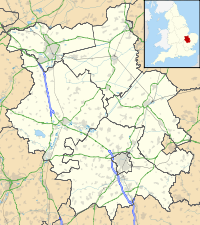- St John the Baptist's Church, Papworth St Agnes
-
St John the Baptist's Church,
Papworth St Agnes
St John the Baptist's Church, Papworth St Agnes,
from the southeastLocation in Cambridgeshire Coordinates: 52°15′50″N 0°08′29″W / 52.2639°N 0.1414°W OS grid reference TL 269 644 Location Papworth St Agnes, Cambridgeshire Country England Denomination Anglican Website Friends of Friendless Churches History Former name(s) St Peter's Church, Papworth St Agnes Dedication John the Baptist Architecture Functional status Redundant Heritage designation Grade II* Designated 31 August 1962 Architectural type Church Style Gothic Revival Groundbreaking 1848 Completed 1854 Specifications Materials Limestone and knapped flint fieldstone flushwork in a chequerboard pattern, tiled roofs St John the Baptist's Church, Papworth St Agnes, is a redundant Anglican church in the village of Papworth St Agnes, Cambridgeshire, England. It has been designated by English Heritage as a Grade II* listed building,[1] and is under the care of the Friends of Friendless Churches.[2]
Contents
Early history
A church was present on the site at the date of the Domesday Survey,[3] and it was replaced by a further church in 1530.[1] By 1827 the chancel of this church had been demolished; at that time it consisted of a west tower and a nave in Perpendicular style.[4] It was almost completely rebuilt in the middle of the 19th century, the tower in 1848 and the rest of the church between 1852 and 1854.[1] The new church incorporated some items from the previous churches.[4] It was designed by the rector at that time, Rev J. H. Sperling.[5]
Architecture
The church is constructed in alternating blocks of limestone and knapped flint fieldstone flushwork, forming a chequerboard pattern, and it has a tiled roof.[1] Its plan consists of a four-bay nave with a north porch, a two-bay chancel with a north vestry, and a west tower. The bays are separated by five-stage buttresses.[2] The tower is in three stages, with similar buttresses at the angles; it has an embattled parapet with gargoyles at the corners. All the windows are arched with three lights and tracery. Both the porch and the vestry are gabled.[1] Items reused from former churches include a doorway dating from the 14th century, the tower arch of the 1530 church, and the gargoyles.[4]
Recent history and present day
During the 20th century the condition of the church deteriorated and by the 1970s it was largely derelict. It was declared redundant in 1976, deconsecrated, and a demolition order was granted.[3] However in 1979 it was taken into the care of the charity the Friends of Friendless Churches.[4] The charity holds the freehold with effect from 5 December 1979.[6] By the time it was taken over, tiles had been removed from the roofs, stained glass designed by William Wailes had been removed, and the font was in the churchyard.[4] The organ dating from about 1860, designed by George Holdich, had also been removed.[7] During the next few years money was raised for repair and restoration, and the Friends of Papworth St Agnes was founded.[3][4] One surviving panel of stained glass was moved to the Stained Glass Museum at Ely Cathedral.[8] As part of the restoration, modern lighting was installed, and a kitchen and toilets were added.[3] Activities in the church were resumed in 2006, the font was returned to the interior of the church, and the stained glass window was also returned.[5] The church is now used as a community centre,[8] and services are occasionally held.[3]
References
- ^ a b c d e "Parish Church of St John the Baptist, Papworth St Agnes", The National Heritage List for England (English Heritage), 2011, http://list.english-heritage.org.uk/resultsingle.aspx?uid=1331388, retrieved 20 May 2011
- ^ a b Papworth St Agnes St John the Baptist, Friends of Friendless Churches, http://www.friendsoffriendlesschurches.org.uk/CMSMS/index.php?page=papworth, retrieved 20 July 2010
- ^ a b c d e Eveleigh, Peter (2000), St John the Baptist, Papworth St Agnes, Papworth Team Ministry, http://www.papworthteamchurches.org/papworthstangeschurch.htm, retrieved 20 July 2010
- ^ a b c d e f History, Friends of Friendless Churches, http://www.friendsoffriendlesschurches.org.uk/CMSMS/index.php?page=history, retrieved 20 July 2010
- ^ a b Saunders, Matthew (2010), Saving Churches, London: Frances Lincoln, pp. 85–86, ISBN 978-0-7112-3154-2
- ^ Churches and chapels owned by the Friends of Friendless Churches: Details for Visitors, London: Friends of Friendless Churches, June 2010
- ^ Saunders, Matthew (2010), Saving Churches, London: Frances Lincoln, pp. 85–86, ISBN 978-0-7112-3154-2
- ^ a b Friends of Papworth St Agnes, Friends of Friendless Churches, http://www.friendsoffriendlesschurches.org.uk/CMSMS/index.php?page=friends-of-papworth, retrieved 20 July 2010
Categories:- Grade II* listed buildings in Cambridgeshire
- Grade II* listed churches
- Churches preserved by the Friends of Friendless Churches
- Religious buildings completed in 1854
- 19th-century Anglican church buildings
- Gothic Revival architecture in England
Wikimedia Foundation. 2010.

